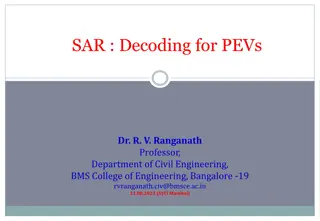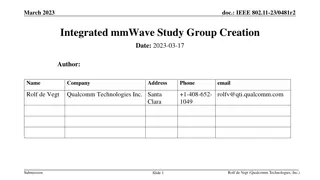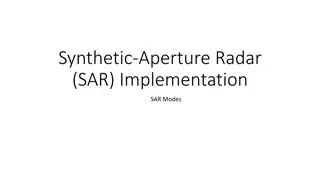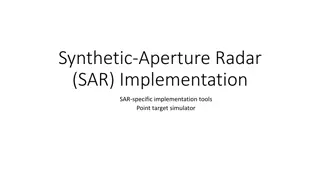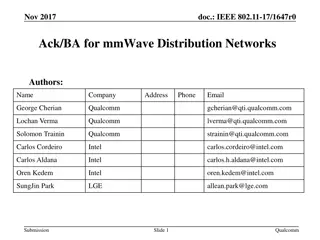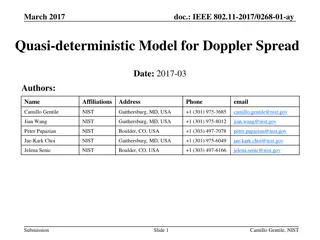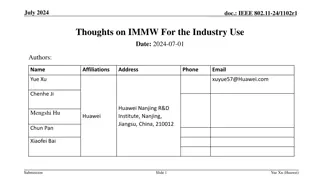mmWave SAR
The world of millimeter wave SAR, including its operating frequencies, system design, and applications such as personal security, ground imaging, automotive imaging, and 3D imaging.
Download Presentation

Please find below an Image/Link to download the presentation.
The content on the website is provided AS IS for your information and personal use only. It may not be sold, licensed, or shared on other websites without obtaining consent from the author.If you encounter any issues during the download, it is possible that the publisher has removed the file from their server.
You are allowed to download the files provided on this website for personal or commercial use, subject to the condition that they are used lawfully. All files are the property of their respective owners.
The content on the website is provided AS IS for your information and personal use only. It may not be sold, licensed, or shared on other websites without obtaining consent from the author.
E N D
Presentation Transcript
mmWave SAR BRANDON RANDOLPH
mmWave Overview Millimeter wavelengths (mmWave) operate between 30 GHz and 300 GHz. Typically, around 35 GHz and 95 GHz are operating frequencies used by many mmWave SAR systems. Utilization of higher operating frequencies allow for larger bandwidths Processing of millimeter SAR does not differ much from SAR applications in the RF band. mmWave SAR applications have ranged from ariel, ground, and space-based systems.
mmWave SAR System Lincoln Laboratory (1991) One of the first mmWave SAR systems was designed by Lincoln Laboratory at MIT [1]. 35 GHz airborne system utilizing an LFM chirp pulse Operational modes: SAR Stripmap, SAR Spotlight, Parameter Specification Polarization Isolation 30 dB Real Aperture Radar, Calibration Bandwidth 600 MHz Stripmap: cross range ~ 440 m Absolute Radar Cross Section 2 dB strip lengths between ~15 and 25 km Relative Radar Cross Section 0.5 dB Relative Polarization Phase 3 deg Spotlight: 150 m by 150 m area Integrated Sidelobe Level -10 dB (Max) RAR: emulates searching and tracking by rotating Peak Sidelobe Level -25 dB (Max) antenna on a gimble Clutter/Noise Ratio 20 dB (Min) Range Resolution 0.3048 m Calibration: controlled transmission of waveform Azimuth Resolution 0.3048 m to verify mission operations Dynamic Range 60 dB Image Registration 1 m
mmWave SAR System MilliCam Prototype (2020) Prototype hand-held mmWave imaging system from Univ. of South Carolina [2]. 60 GHz mobile device utilizing chirp-based SAR imaging from COTS parts compliant with IEEE 802.11ad networking standard Emulates SAR principles by waving the device over the air to create SAR array. Parameter Specification Bandwidth 1.76 GHz Cross-range resolution (theoretical) 1 cm (for 50 cm aperture) Range resolution 8.5 cm Range operation 1~1.5 m Image Frame Generation Time 1.25 s a) MilliCam Prototype board [2] b) Baseline SAR imaging system with motion tracker [2]
Applications of mmWave SAR Personal security and surveillance Ground image detection Automotive Imaging 3D imaging
Personal Security Hand-held Imaging [2][3] Due to 5G technology, COTS components and systems are allowing the use of mmWave devices. Along with MilliCam, other concept imaging devices have been proposed that utilize stereoscopic cameras for localization and mapping. Concept of hand-held imaging system [4]
Left [2]: Metallic shaped objects Right [2]: MilliCam output image Left [2]: Plastic gun Middle [2]: Plastic gun replica hidden inside cloth Right [2]: Composite image of mmWave SAR and (b)
Concealed object scenarios (Left) vs corresponding near-field SAR images (Right) [4]
Personal Security Surveillance [5] Surveillance systems have also been explored utilizing stepped frequency for target detection. mmWave radar system setup [4] Target scenario and post-processed mmWave SAR image [4]
Ground Imaging Power Line Detection [6] Backscatter properties of high-voltage power lines differ as not modeled by straight cylinders. Transmit-Receive polarizations SAR system with operating frequencies of 35 GHz and 94 GHz flown over field Reflection points of 30 cm Power cable [6]
Left [6]: SAR Image with system operating at 35 GHz Right [6]: SAR Image with system operating at 94 GHz
Automotive Imaging Target Detection [7] Optical camers and LIDAR systems suffer in harsh weather conditions whereas mmWave radar system are able to operate. For experiment, speed of vehicle was at 5 km (~ 3 mph) and utilized an LFM pulse with a bandwidth of 900 MHz, center frequency 76.5 GHz, and 0.5 ms period. Back projection algorithm was used for processing Front-looking mmWave setup; aperture image; SAR image [7]
3D Imaging [8] Left [8]: Mannequin scenario with various objects attached Right [8]: Near Field SAR image and 3D reconstruction
Sources [1] J. C. Henry, "The Lincoln Laboratory 35 GHz airborne SAR imaging radar system," NTC '91 - National Telesystems Conference Proceedings, 1991, pp. 353-358, doi: 10.1109/NTC.1991.148045. [2] M. S. Saadat, S. Sur, S. Nelakuditi and P. Ramanathan, "MilliCam: Hand-held Millimeter-Wave Imaging," 2020 29th International Conference on Computer Communications and Networks (ICCCN), 2020, pp. 1-9, doi: 10.1109/ICCCN49398.2020.9209710. [3] G. lvarez-Narciandi, J. Laviada and F. Las-Heras, "Towards Turning Smartphones Into mmWave Scanners," in IEEE Access, vol. 9, pp. 45147- 45154, 2021, doi: 10.1109/ACCESS.2021.3067458. [4] M. E. Yanik and M. Torlak, "Near-Field 2-D SAR Imaging by Millimeter- Wave Radar for Concealed Item Detection," 2019 IEEE Radio and Wireless Symposium (RWS), 2019, pp. 1-4, doi: 10.1109/RWS.2019.8714552.
Sources [5] A. S. Turk, A. Kizilay, M. Orhan and A. Caliskan, "High resolution signal processing techniques for millimeter wave short range surveillance radar," 2016 17th International Radar Symposium (IRS), 2016, pp. 1-4, doi: 10.1109/IRS.2016.7884697. [6] H. Essen, S. Boehmsdorff, G. Biegel and A. Wahlen, "On the scattering mechanism of power lines at millimeter-waves," in IEEE Transactions on Geoscience and Remote Sensing, vol. 40, no. 9, pp. 1895-1903, Sept. 2002, doi: 10.1109/TGRS.2002.805144. [7] H. Yamada, T. Kobayashi, Y. Yamaguchi and Y. Sugiyama, "High-resolution 2D SAR imaging by the millimeter-wave automobile radar," 2017 IEEE Conference on Antenna Measurements & Applications (CAMA), 2017, pp. 149- 150, doi: 10.1109/CAMA.2017.8273384. [8] F. Gumbmann and L. Schmidt, "Millimeter-Wave Imaging With Optimized Sparse Periodic Array for Short-Range Applications," in IEEE Transactions on Geoscience and Remote Sensing, vol. 49, no. 10, pp. 3629-3638, Oct. 2011, doi: 10.1109/TGRS.2011.2164616.






